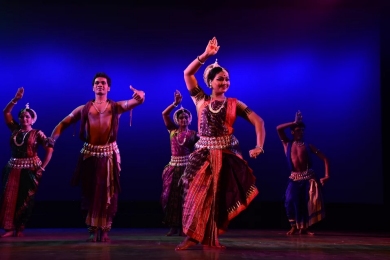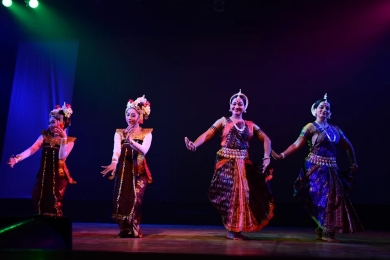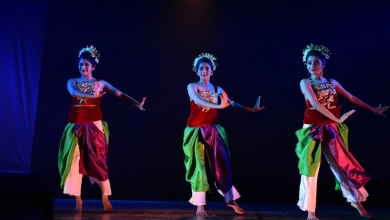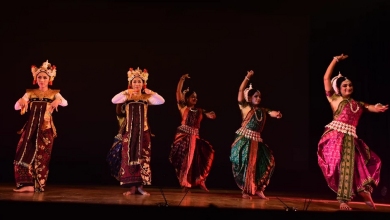
|   |

|   |
 e-mail: leelakaverivenkat@gmail.com Recall the then to plan the now of the Kalinga Indonesia Dialogue Photos courtesy: Orissa Dance Academy December 13, 2016 How does a seminar on an interaction between two countries, relate to a dance event, one may well ask. It does, specially, when the regions involved are Indonesia and what was the then Kalinga Empire in India, which comprised much of present day Odisha. There was also the special relationship with Indonesia shared by late Chief Minister of Odisha, Biju Patnaik, whose significant interventions at a very important point in Indonesian history earned him recognition as 'Bhumi Putra'. The Sadabha-s who set sail from ancient Kalinga, took with them their ideas too, to the countries they traded with. If Odisha events like 'Boita Bandana', the Ballad of "Taw-Poi" and Khudurukuni Osa and "A-Ka-Ma-Bai" in Odisha are a throwback of the past ties, the temples of Angkor Wat, Angkor Thom, the Javanese Prambanan, names like Sita Suleiman and Maulana Vishnu (mentioned in his talk by Prof. V. Suryanarayana specialising in South and South-East Asian studies), Buddhist monuments and flourishing Hinduism in Bali and pockets of other places like Java and Sumatra in Indonesia tell their own tales of the past interactions. Two highly populous nations, multi-ethnic, multi-religious and multi-cultural, India and Indonesia apart from shared values, have been linked by over two thousand year old cultural ties. Both won independence in mid-twentieth century, shaking off the shackles of years of colonial domination. 

Mounted in Ravenshaw University of Cuttack (Odisha), The Kalinga Indonesia Dialogue, spearheaded by Ambassador Lalit Mansingh, President of the Kalinga Lanka Foundation, with sponsors like the ICCR, and the FICCI was a crackling three day exchange among high profile delegates led by the Ambassador of Indonesia in India, Rizali Wilmar Indrakesuma and several ex-ambassadors, professors, scholars and historians. Coinciding with the symbolic sailing of boats on Kartik Purnima during Bali Jatra, an annual event comprising a nostalgic recapture of past history begun in 1992-'93 in a re-enactment of historical maritime activity between Kalinga and Indonesia, with the INS Samudra sailing from Paradeep to Bali, to be followed by a seminar in Bali in 1993 with eminent Indian and Indonesian scholars participating, the recent dialogue was not meant to descend into a nostalgic recall of history, but to engage in a robust search for ways of activating strategic and economic interaction, which over the years through euphoric and less happy moments, has not lived up to its potential. Bhaba Sangama as the artistic representation for this interaction of India and Indonesia, saw Odissi and Balinese dancers in confluence. The Odissi dancers were from the Odissi Dance Academy at Bhubaneswar led by dancer Aruna Mohanty. The two very attractive Balinese dancers with names that spoke of the old Sanskrit heritage straight away were Dewa Ayu Eka Putri, dancer/ musician/ teacher at Cudamani Dance and Music Foundation and Ida Ayu Wayan Prihandari, dance and music teacher of Maha Bajra Sandhi Dance and Music Foundation. A fine visual on the back curtain of an ancient ornate large boat spoke of how the story of relationships began. There were also evocative visuals of Ravana Chhaya puppets, Puppets of Wayangkuli - though the technical side of projecting these was less than smooth - with jagged halts. The dance itself, with background research work done by Kedar Misra, very intelligently showed in bright snippets the cultural similarities between India and Bali through festivals, architecture, the shared approach to temple ritual and expressions of folk culture. The wise approach was to bring together folk influences and forms like Chhau instead of being bound by the strict confines of classical Odissi only. The obvious bond lay in the theme of the Ramayana, which our sea travellers took to so many regions outside, and in each area, the epic story has taken on a unique artistic cultural manifestation. It is to the credit of choreographer Aruna Mohanty that the dance forms from two regions, sharing a mindset though very different in technique, melded so smoothly. The Balinese dancer with her grace made a wonderful Sita at Ashoka-vana. A Chhau dancer who has been trained in Javanese dance played Ravana as depicted in their presentations, the grandeur of this character also brought out. The golden deer was another Indian dancer performing in Balinese style. Male dancers in Chhau movements were a pleasure to watch. The Choodamani Pradanam scene, Lanka being set on fire by Hanuman's torched tail, the Setu-bandhan by the army of monkeys enabling the crossing of the seas to Lanka, and the sensitive scene showing Sita going through the fire ordeal were all presented with finesse and exemplary movement coordination. 

The demonstration accompanied by brief explanations the next evening, very clearly worked out by Aruna in consultation with the Balinese dancers, shed light on some important aspects. Balinese temple dance is a living art form, practiced in the temples even today. Terminology, like 'itihasa', 'Sakti', 'Purusha', 'Purusha Pradhana' prove the shared Sanskritic influences in India and Bali. While Odissi has the 'Chauka' (square) plie as its central stylistic concern in body movement along with the tribhanga, Balinese dance has a tribhanga but which is a less open stance, with the two knees bent forwards and held close together on one side - resembling Manipuri. Technique, for the male and female dancer is clearly codified. And the male dance form was mentioned as having a more open stance -with the knees spread out. The hands and fingers, unlike Manipuri, are fully stretched in very clearly etched hastas. The fluttering fingers like the leaves of a tree when there is a breeze, and the way the hand and fingers seem to articulate finishing points of a rhythmic metre are very distinctive. Moving marking rhythm on heels (begine) as in Odissi, is common. The basic body positions (angam), transition points in a movement were all demonstrated. As in Indian dance, Nature and particularly animal movements have provided inspiration for different types of gait (chali). A striking aspect is facial expression with eyes playing a very important part. Not as codified as in the abhinaya of Indian classical dance, the dancers spoke of 'Rama, Rasa and Raga' as the important features. The music is very different and while one dancer softly crooned and the other danced, it was made clear that this provided only a skeletal idea of Balinese dance which has a very large orchestral accompaniment - where even percussion instruments are classified as male and female - with the Gamelan playing an important part. An interesting point were the vocalization bits - the sounds uttered in a metre, perhaps a substitute for the rhythmic syllables used in Indian dances. Categories of heroines like khandita were portrayed in glimpses by both Odissi and Balinese dancers. An event which all viewers found regaling, such interactions between Indonesian and Indian art forms are all to the good.  Writing on the dance scene for the last forty years, Leela Venkataraman's incisive comments on performances of all dance forms, participation in dance discussions both in India and abroad, and as a regular contributor to Hindu Friday Review, journals like Sruti and Nartanam, makes her voice respected for its balanced critiquing. She is the author of several books like Indian Classical dance: Tradition in Transition, Classical Dance in India and Indian Classical dance: The Renaissance and Beyond. Post your comments Please provide your name and email id when you use the Anonymous profile in the blog to post a comment. All appropriate comments posted with name & email id in the blog will also be featured in the site. |